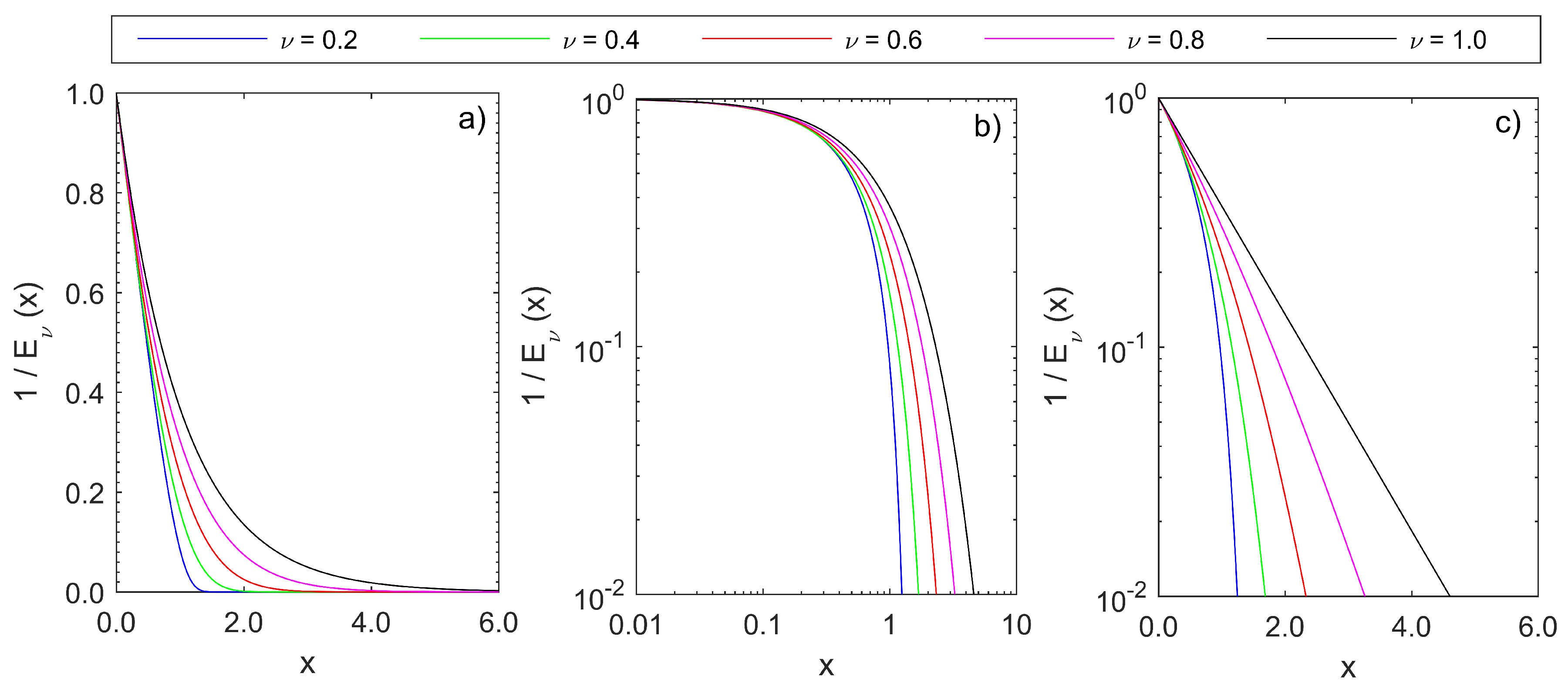Towards a Generalized Beer-Lambert Law
Abstract
:1. Introduction
2. Beer-Lambert Law Stochastic Interpretation
3. Generalizations of the Beer-Lambert Law Based on Weighted Poisson Distributions
4. Weighted Beer-Lambert Law in Inhomogeneous Media
Acknowledgments
Author Contributions
Conflicts of Interest
References
- Fuente, D.; Lizama, C.; Urchueguía, J.F.; Conejero, J.A. Estimation of the light field inside photosynthetic microorganism cultures through Mittag-Leffler functions at depleted light conditions. J. Quant. Spectrosc. Radiat. Transf. 2018, 204, 23–26. [Google Scholar] [CrossRef]
- Patterson, M.; Hughes, S. Disorder-induced incoherent scattering losses in photonic crystal waveguides: Bloch mode reshaping, multiple scattering, and breakdown of the Beer-Lambert law. Phys. Rev. B 2009, 80, 195305. [Google Scholar] [CrossRef]
- Scholl, T.; Pfeilsticker, K.; Davis, A.B.; Klein, B.H.; Crewell, S.; Lohnert, U.; Simmer, C.; Meywerk, J.; Quante, M. Path length distributions for solar photons under cloudy skies: Comparison of measured first and second moments with predictions from classical and anomalous diffusion theories. J. Geophys. Res. 2006, 111, D12211. [Google Scholar] [CrossRef]
- Şen, M.; Çalık, A.E.; Ertik, H. Determination of half-value thickness of aluminum foils for different beta sources by using fractional calculus. Nucl. Instrum. Methods Phys. Res. 2014, 335, 78–84. [Google Scholar] [CrossRef]
- Yun, Y.; Park, J. Attenuation of monochromatic and polychromatic lights in Chlorella vulgaris suspensions. Appl. Microbiol. Biotechnol. 2001, 55, 765–770. [Google Scholar] [CrossRef] [PubMed]
- Davis, A.B.; Xu, F.; Diner, D.J. Generalized Radiative Transfer Theory for Scattering by Particles in an Absorbing Gas: Addressing Both Spatial and Spectral Integration in Multi-angle Remote Sensing of Optically Thin Aerosol Layers. J. Quant. Spectrosc. Radiat. Transf. 2017, in press. [Google Scholar] [CrossRef]
- Kostinski, A. On the extinction of radiation by a homogeneous but a spatially correlated random medium. J. Opt. Soc. Am. A 2001, 18, 1929–1933. [Google Scholar] [CrossRef]
- Oldham, K.B. The propagation of radiation through a medium containing a component that absorbs the radiation and is steadily destroyed by it. J. Math. Chem. 2014, 52, 1007–1019. [Google Scholar] [CrossRef]
- Casasanta, G.; Ciani, D.; Garra, R. Non-exponential extinction of radiation by fractional calculus modelling. J. Quant. Spectrosc. Radiat. Transf. 2012, 113, 194–197. [Google Scholar] [CrossRef]
- Ibrahim, R.; Ozel, C. On Multi-Order Fractional Differential Operators in the Unit Disk. Filomat 2016, 30, 73–81. [Google Scholar] [CrossRef]
- Tramontana, V.; Casasanta, G.; Garra, R.; Iannarelli, A.M. An application of Wright functions to the photon propagation. J. Quant. Spectrosc. Radiat. Transf. 2013, 124, 45–48. [Google Scholar] [CrossRef]
- Liemert, A.; Kienle, A. Radiative transport equation for the Mittag-Leffler path length distribution. J. Math. Phys. 2017, 58, 053511. [Google Scholar]
- Liemert, A.; Kienle, A. Fractional radiative transport in the diffusion approximation. J. Math. Chem. 2017. [Google Scholar] [CrossRef]
- Shaw, R.A.; Kostinski, A.B.; Lanterman, D.D. Super-exponential extinction of radiation in a negatively correlated random medium. J. Quant. Spectrosc. Radiat. Transf. 2002, 75, 13–20. [Google Scholar] [CrossRef]
- Fernández, F.G.A.; Camacho, F.G.; Pérez, J.A.S.; Sevilla, J.M.F.; Grima, E.M. A model for light distribution and average solar irradiance inside outdoor tubular photobioreactors for the microalgal mass culture. Biotechnol. Bioeng. 1997, 55, 701–714. [Google Scholar] [CrossRef]
- Kumar, D.; Singh, J.; Baleanu, D. A new numerical algorithm for fractional Fitzhugh–Nagumo equation arising in transmission of nerve impulses. Nonlinear Dyn. 2018, 91, 307–317. [Google Scholar] [CrossRef]
- Singh, J.; Kumar, D.; Baleanu, D. On the analysis of chemical kinetics system pertaining to a fractional derivative with Mittag-Leffler type kernel. Chaos 2017, 27, 103113. [Google Scholar] [CrossRef] [PubMed]
- Gloeckle, W.G.; Nonnenmacher, T.F. Fractional integral operators and Fox functions in the theory of viscoelasticity. Macromolecules 1991, 24, 6426–6434. [Google Scholar] [CrossRef]
- Metzler, R.; Schick, W.; Kilian, H.G.; Nonnenmacher, T.F. Relaxation in filled polymers: A fractional calculus approach. J. Chem. Phys. 1995, 103, 7180–7186. [Google Scholar] [CrossRef]
- Metzler, R.; Klafter, J. The random walk’s guide to anomalous diffusion: A fractional dynamics approach. Phys. Rep. 2000, 339, 1–77. [Google Scholar] [CrossRef]
- Balakrishnan, N.; Kozubowski, T.J. A class of weighted Poisson processes. Stat. Probab. Lett. 2008, 78, 2346–2352. [Google Scholar] [CrossRef]
- Gorenflo, R.; Kilbas, A.A.; Mainardi, F.; Rogosin, S.V. Mittag–Lefflerfunctions. Related Topics and Applications; Springer: Berlin/Heidelberg, Germany, 2014. [Google Scholar]
- Beghin, L.; Orsingher, E. Fractional Poisson processes and related planar random motions. Electron. J. Probab. 2009, 14, 1790–1826. [Google Scholar] [CrossRef]
- Herrmann, R. Generalization of the fractional Poisson distribution. Fract. Calc. Appl. Anal. 2016, 19, 832–842. [Google Scholar] [CrossRef]
- Chakraborty, S.; Ong, S.H. Mittag–Leffler function distribution—A new generalization of hyper-Poisson distribution. J. Stat. Distrib. Appl. 2017, 4, 8. [Google Scholar] [CrossRef]
- Kostinski, A. On the extinction of radiation by a homogeneous but spatially correlated random medium: Reply to comment. JOSA A 2002, 19, 2521–2525. [Google Scholar] [CrossRef]
- Mandel, L.; Wolf, E. Optical Coherence and Quantum Optics; Cambridge University Press: New York, NY, USA, 1995. [Google Scholar]
- Palmeira, T.; Berberan-Santos, M.N. Are super-exponential luminescence decays possible? Chem. Phys. 2014, 445, 14–20. [Google Scholar] [CrossRef]
- Frankel, A.; Iaccarino, G.; Mani, A. Convergence of the Bouguer–Beer law for radiation extinction in particulate media. J. Quant. Spectrosc. Radiat. Transf. 2016, 182, 45–54. [Google Scholar] [CrossRef]

© 2018 by the authors. Licensee MDPI, Basel, Switzerland. This article is an open access article distributed under the terms and conditions of the Creative Commons Attribution (CC BY) license (http://creativecommons.org/licenses/by/4.0/).
Share and Cite
Casasanta, G.; Garra, R. Towards a Generalized Beer-Lambert Law. Fractal Fract. 2018, 2, 8. https://doi.org/10.3390/fractalfract2010008
Casasanta G, Garra R. Towards a Generalized Beer-Lambert Law. Fractal and Fractional. 2018; 2(1):8. https://doi.org/10.3390/fractalfract2010008
Chicago/Turabian StyleCasasanta, Giampietro, and Roberto Garra. 2018. "Towards a Generalized Beer-Lambert Law" Fractal and Fractional 2, no. 1: 8. https://doi.org/10.3390/fractalfract2010008




